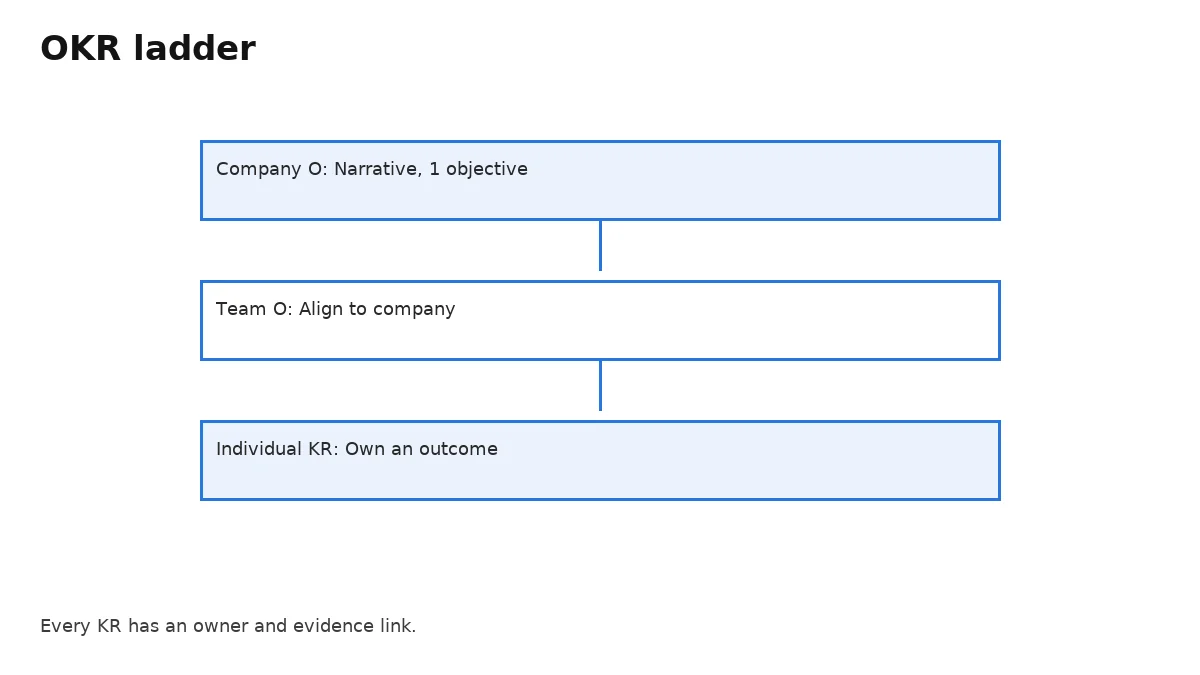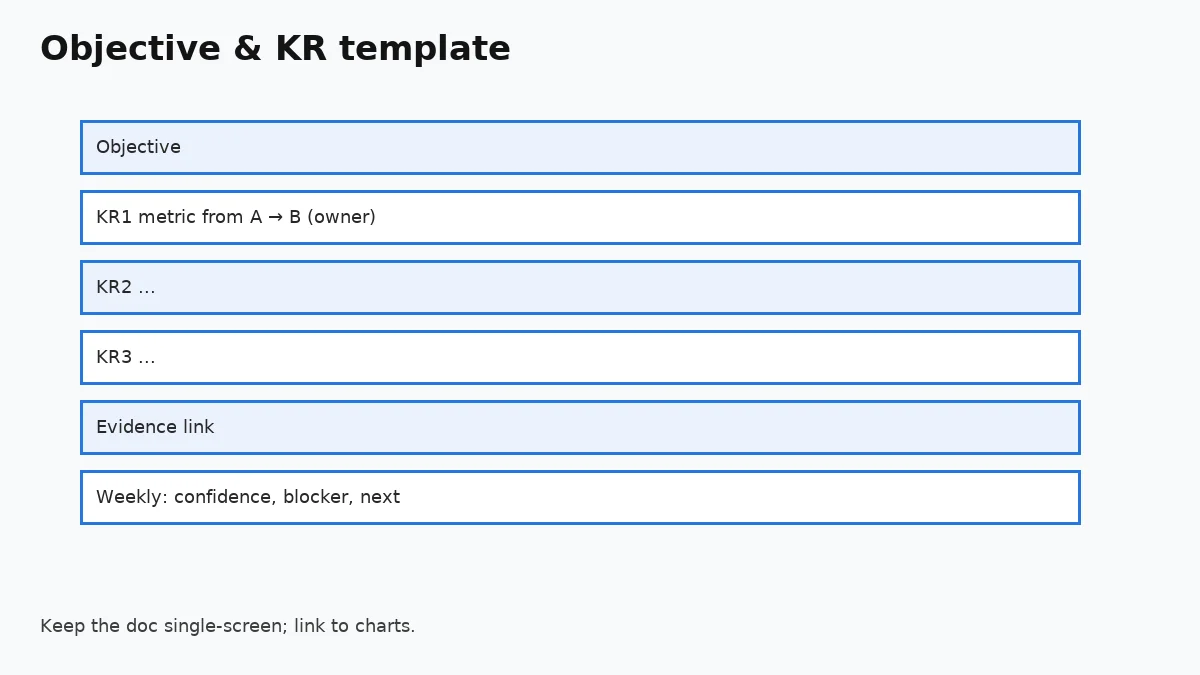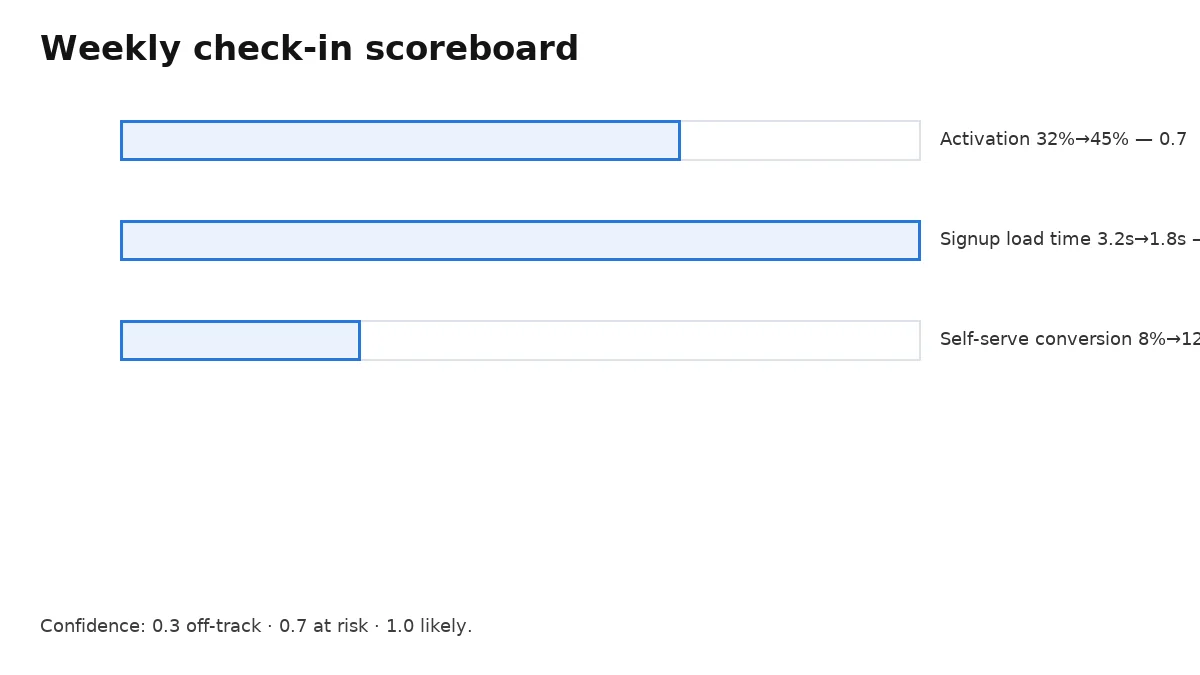Quarterly cadence, example OKRs, Notion template.
OKRs work for small teams when they’re simple and visible. This playbook shows how to write crisp Objectives and measurable Key Results, ladder team goals to the company mission, run a quarterly cadence with weekly check‑ins, and use confidence scoring to adapt without theatre.
Key takeaways: Keep one company Objective and at most three team OKRs. Each KR is a measurable outcome, not a task. Run a weekly 15‑minute check‑in with confidence scores (0.3/0.7/1.0). No sandbagging, no vanity metrics—just focus and learning.
Focus, visibility, and honest weekly check‑ins.
Write one company Objective with 2–4 measurable KRs; each team takes one Objective that ladders up. Check progress weekly, score confidence, and prune anything that doesn’t move the needle.
A 10‑person team can’t chase ten priorities. Limit work‑in‑progress, publish OKRs in a single doc, and make KRs owner‑clear. If a KR becomes a task list, rewrite it as an outcome.

Start with one company Objective that expresses the narrative. Teams pick Objectives that directly contribute; individuals own specific KRs.
Company O: “Win our ICP with a lovable onboarding.” Product O: “Activation feels instant.” Sales O: “Convert trials without hand‑holding.” Each KR has an owner and evidence source (query/report).

Objectives are qualitative and inspiring; Key Results are quantitative outcomes with a baseline and target, not tasks or activities.
Good KR: “Activation ≥45% (from 32%).” Bad KR: “Ship new onboarding.” Add the evidence source (analytics report) and review cadence.
Plan quarterly in 90 minutes; review weekly in 15. Mid‑quarter, prune or pivot one KR if evidence demands it.
Week 0: set OKRs and owners. Weeks 1–11: weekly check‑in (metrics + confidence). Week 6: adjust one KR if needed. Week 12: score and retro.

Each KR owner reports a confidence level: 0.3 off‑track, 0.7 at risk but feasible, 1.0 likely. Discuss deltas, not excuses.
Capture one blocker and one next action per KR. If confidence stays at 0.3 for two weeks, change the plan or the KR.
Too many OKRs, KR = task list, vanity metrics, and neglecting weekly check‑ins kill the system.
Fix by limiting to one company Objective, three team OKRs, and 2–4 KRs each. Tie KRs to source charts and keep the ritual short and honest.
Use a single doc or sheet. A table with Objective, KR, owner, baseline, target, evidence link, confidence, blockers, and next action is enough.
Objective: ______
KR1: metric from A to B (owner, evidence link)
KR2: ...
KR3: ...
Weekly: confidence 0.3/0.7/1.0; blocker; next action
If you publish OKRs, keep INP ≤200 ms, LCP ≤2.5 s, CLS ≤0.1. Static pages beat heavy embeds.
Render charts as images (WebP), preconnect to your CDN, and set width/height to avoid layout shifts.
Related reads: Monthly Investor Update Template, Board Meeting Playbook, Seed–A Financial Model Template.
Use outcome‑based wording and show the baseline → target.
Avoid debates by adding formula, source, owner, and cadence next to each KR.
Fast, collaborative, and decisive.
Review deltas only; keep it tight.
Score KRs 0.0–1.0; average to the Objective score; capture 3 lessons.
Share wins and misses openly. Scores inform the next quarter but do not automatically drive compensation for small teams—use judgement to avoid perverse incentives.
Don’t hard‑link OKRs to pay in a tiny start‑up.
When resources are volatile, hard links encourage sandbagging. Use OKRs to focus, then make compensation decisions holistically based on scope, impact, and market data.
Asynchronous by default, live where it matters.
Fix the system, not the people.
Objective: qualitative direction. Key Result: quantitative outcome. TTFV: time to first value. Confidence: likelihood the KR will be met (0.3/0.7/1.0).
Quarterly planning; weekly check‑ins; monthly demo.
Archive each quarter’s OKR doc with YYYY‑Q naming and a one‑page summary. During fundraising or fast pivots, shorten the cycle but keep the ritual consistent.
Quick answers on OKRs for tiny teams.
Want OKRs that help you ship, not posture?


© EA Partners 2025. All Rights Reserved.